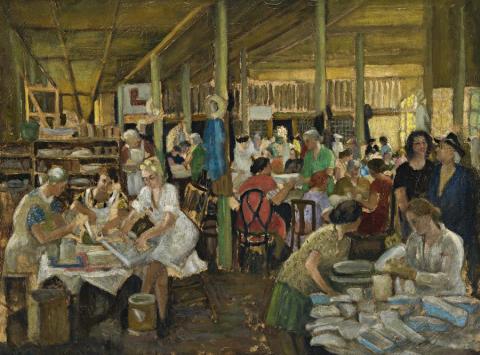PAPIER MACHE, RED CROSS AUXILIARY IN SYDNEY, c.1944
ETHEL CARRICK FOX
oil on canvas
57.0 x 73.0 cm
signed lower left: CARRICK
Private collection, Sydney
Thence by descent
Private collection, Sydney
Pictures from the Late E Phillips Fox and E Carrick Fox, Athenaeum Gallery, Melbourne, 8–19 February 1944, cat. 13
Ethel Carrick Fox lived in Australia during the Second World War, her active support of the war effort echoing the efforts she and many Australian artists made during the previous Great War of 1914-18. She was honorary secretary of the Australian Artists' War Fund Exhibition and worked with the French-Australian Association to assist Australian artists stranded in Paris. In 1942, half the proceeds from the Emanuel Phillips Fox - Carrick Fox exhibition at Melbourne's Athenaeum Gallery were donated to the war fund. She also gave a painting to the women's committee of the Fighting French Movement. Curiously, her application to become an Australian war artist was unsuccessful. Nevertheless Carrick completed a series of paintings, including papier-mâché, Red Cross Auxiliary in Sydney c1944, recording the dedicated, voluntary activities of women working for the war effort.It is curious to reflect on whether her long time friend Rupert Bunny had any influenceon these paintings. Bunny was a volunteer in the ambulance section of Anglo-French-American Hospital, during the winter of 1914-15. His experiences led him to paint Waiting to be X-Rayed, (American Red Cross) 1915, (collection of the Australian War Memorial, Canberra), and Salle des Bandages (Ambulance Américanè) 1915. Although quite different from Carrick's paintings, there is a distant family likeness in the subject of the latter painting. More particularly, Carrick may have recalled Bunny's paintings when she turned to make her own on the occasion of a later war. This notion is strengthened when recalling the diversity of Australian women artists' response to the war. On the home front, Grace Cossington Smith's subjects were church services of thanksgiving. Margaret Preston's were more diverse - protection against air raids in General Post Office, Sydney 1942 (Art Gallery of South Australia, Adelaide) or Tank Traps 1943 (Mornington Peninsula RegionalGallery, Victoria).
Carrick's volunteer women paintings were shown in 1944 in her joint exhibition with her late husband, again at the Athenaeum. For Papier Mâché, Red Cross Auxiliary in Sydney the exhibition catalogue included the note - 'These workers have made 50,000 articlesof hospital equipment for the Navy, Army and Air Force hospitals, dressing stations and convalescent homes.' Another of the series, National Defence League Depot, St Michael's Hall, Sydney 1942, is rightly in the collection of the Australian War Memorial - of volunteers making camouflage nets. Another, The Canteen Workers c1944 (private collection), was recently seen in the Queensland Art Gallery's major exhibition of Phillips and Carrick Fox's works, illustrated in the accompanying catalogue.1 All three are peopled entirely by women - engaged and active - a striking comment on the voluntary contribution made by women to the war effort.
1. Probably The Kitchen, Canberra Services Club. See Goddard, A., et al, Art, Love and Life: Ethel Carrick and E. Phillips Fox, Queensland Art Gallery, Brisbane, 2011, p. 65
DAVID THOMAS
